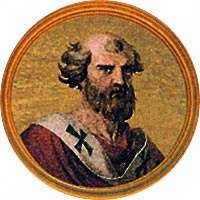Pope Celestine II
| Pope Celestine II | |
|---|---|
 | |
| Papacy began | 26 September 1143 |
| Papacy ended | 8 March 1144 |
| Predecessor | Innocent II |
| Successor | Lucius II |
| Personal details | |
| Birth name | Guido di Castello |
| Born | Città di Castello, Papal States, Holy Roman Empire |
| Died |
8 March 1144 Rome, Papal States, Holy Roman Empire |
| Other popes named Celestine | |
| Papal styles of Pope Celestine II | |
|---|---|
 | |
| Reference style | His Holiness |
| Spoken style | Your Holiness |
| Religious style | Holy Father |
| Posthumous style | none |
Pope Celestine II (Latin: Caelestinus II; died 8 March 1144), born Guido di Castello,[1] was Pope from 26 September 1143[2] to his death in 1144. He is the first pope mentioned in the prophecy of Saint Malachy.
Early life
Guido di Castello, possibly the son of a local noble, Niccolo di Castello,[3] was born either in Città di Castello, situated in Paterna Santa Felicità upon the Apennines, or at Macerata in the March of Ancona.[3][4]
Guido had studied under Pierre Abélard, and eventually became a distinguished master in the schools.[3] Eventually Guido began his career in Rome as a subdeacon and a scriptor apostolicus under Pope Callixtus II.[3] He was created Cardinal-Deacon of Santa Maria in Via Lata by Pope Honorius II in 1127;[5] as such, he signed the papal bulls issued between 3 April 1130 and 21 December 1133.[6] In the double papal election of 1130 he joined the obedience of Pope Innocent II. In December 1133 Innocent promoted him to the rank of Cardinal-Priest of San Marco.[5] He signed the papal bulls as S.R.E. indignus sacerdos between 11 January 1134 and 16 May 1143.[7] As the cardinal of San Marco’s, he supported Innocent’s claims with regards to Monte Cassino, and as a mark of his confidence in him, Innocent made Guido the rector of Benevento. Afterwards, he made him a papal legate to France in 1140.[1]
He participated in the papal election of 1143, the first undisturbed papal election that Rome had seen for eighty-two years,[8] and was elected pope two days after the death of Innocent II,[9] on 25 September 1143,[1] taking the name of Celestine.[8]
Papacy
Celestine II governed the Church for only five months and thirteen days from his election until his death on 8 March 1144. Upon his accession he wrote to Peter the Venerable and the monks of Cluny, asking them to pray for him, while he was congratulated by Arnulf of Lisieux.[10] Regardless of the brevity of his reign, he was prepared to chart a very different course from that of his predecessor. He was opposed to Innocent II’s concessions to King Roger II of Sicily[11] and was in favor of the House of Plantagenet’s claim to the English throne, thus opposed to King Stephen of England. To emphasise this shift, he refused to renew the legatine authority that Innocent II had granted to King Stephen’s brother, Henry of Blois.[11] Celestine also favored the Templars, ordering a general collection for them, as well as the Hospitallers, giving them control of the hospital of Saint Mary Teutonicorum in Jerusalem.[12]
The principal act of his papacy was the absolution of Louis VII of France.[11] King Louis had refused to accept the nomination of Pierre de la Chatre as the Archbishop of Bourges, who went to see Innocent II to have his nomination confirmed.[13] When Pierre returned to France in 1142, Louis refused him permission to enter his Episcopal city, causing Pierre to flee to the court of Theobald II, Count of Champagne. Innocent responded by placing France under an interdict.[13] For two years, the various parties remained at loggerheads while Bernard of Clairvaux attempted to mediate the dispute.[14] With the election of Celestine, both Bernard and Theobald appealed to the pope, while Louis sent ambassadors to have the interdict lifted.[15] Louis agreed to accept Pierre as the legitimate Archbishop of Bourges, and in return, Celestine removed the sentence of interdict.[12]
Celestine died on 8 March 1144[1] in the monastery of Saint Sebastian on the Palatine hill and was buried in the south transept of the Lateran.[12] Celestine’s heraldic badge was a lozengy shield of argent and gules.[9]
Celestine II is the first pope listed in the Prophecies of St Malachy.
Sources
- Thomas, P. C., A Compact History of the Popes, St Pauls BYB, 2007
- Mann, Horace K., The Lives of the Popes in the Middle Ages, Vol 9 (1925)
External links
| Wikisource has the text of the 1911 Encyclopædia Britannica article Celestine (popes). |
References
- 1 2 3 4 Thomas, pg. 91
- ↑ http://www2.fiu.edu/~mirandas/bios1127.htm#Castello
- 1 2 3 4 Mann, pg. 105
- ↑ According to Mann (pg. 104), there is a local tradition that Celestine II, when he became pope, presented the cathedral in Città di Castello with a sculptured silver altar-front.
- 1 2 Mann, pg. 106
- ↑ J.M.Brixius, Die Mitglieder des Kardinalkollegiums von 1130–1181, Berlin, 1912, p. 35 no. 19
- ↑ J.M.Brixius, Die Mitglieder des Kardinalkollegiums von 1130–1181, Berlin, 1912, p. 35 no. 19 and p. 43 no. 23, indicates that Guido del Castello and Guido S.R.E. indignus sacerdos were two different persons; but see L. Spätling, Kardinal Guido und seine Legation in Böhmen-Mähren (1142–1146) in: Mitteilungen des Instituts für österreichische Geschichtsforschung, Wagner'sche Universitäts-buchhandlung, 1958, p. 310
- 1 2 Mann, pg. 103
- 1 2 Mann, pg. 102
- ↑ Mann, pgs. 106–107
- 1 2 3 Mann, pg. 108
- 1 2 3 Mann, pg. 111
- 1 2 Mann, pg. 109
- ↑ Mann, pgs. 109–110
- ↑ Mann, pgs. 110–111
| Catholic Church titles | ||
|---|---|---|
| Preceded by Innocent II |
Pope 1143–44 |
Succeeded by Lucius II |
